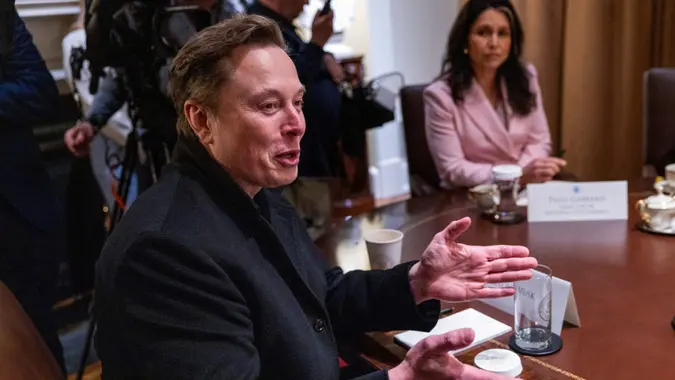Elon Musk Hates ‘Phoning It In’ — How What He Does at Tesla Affects DOGE

Commitment to Our Readers
GOBankingRates' editorial team is committed to bringing you unbiased reviews and information. We use data-driven methodologies to evaluate financial products and services - our reviews and ratings are not influenced by advertisers. You can read more about our editorial guidelines and our products and services review methodology.

20 Years
Helping You Live Richer

Reviewed
by Experts

Trusted by
Millions of Readers
The Department of Government Efficiency (DOGE), headed by Elon Musk, was a key promise in President Donald Trump’s campaign to cut excessive federal spending. Musk has operated many successful companies with multi-billion dollar valuations, and seeing how he manages those companies can offer hints for how he approaches DOGE.
Musk is pretty hardcore when it comes to commitment: He used to sleep on Tesla’s factory floor because he didn’t have time to go home and shower. He also reportedly slept in his X office for many days, shortly after acquiring Twitter and changing its name.
He’s not requiring federal employees to sleep in the office. That would be a bit too much. However, his stances around other issues are more feasible — but may cause some friction.
No Remote Work
Elon Musk has made his stance against remote work quite public. He told Tesla staff to stop “phoning it in” and get back to the office in 2022, shortly after COVID-19 pandemic restrictions were lifted. He told his employees to work a minimum 40 hours per week in the office, and he’s even gone as far as to say that working from home is “morally wrong.”
Many federal workers won’t want to give up their ability to work remotely, but Trump and DOGE have also pushed forward on this matter. Trump announced a return-to-office mandate for federal workers shortly after his inauguration.
Cutting remote work will force people to show up, and it could remove federal workers who haven’t been as productive.
It’s an efficient route, but it can also limit talent — some workers are capable of obtaining federal jobs but prefer to live far away from Washington, D.C., to save on costs or simply for a different lifestyle. DOGE still needs enough federal workers to keep the government running, but it will have to exclusively source from local talent.
Musk Likes Lean Teams
Musk isn’t shy when it comes to firing workers to boost efficiency, and this trend plays out in multiple companies. For instance, Tesla laid off 10% of its global workforce in April 2024, and it has been speculated that more layoffs may be on the way due to Tesla’s sharp profit decline in Q1 2025.
While Tesla has made periodic cuts, the most noteworthy cuts came from X. Within a few months of acquiring X, Musk proceeded to fire more than 80% of the staff. Although there were many concerns about X’s viability after such a dramatic cut in the workforce, the platform remains operational.
This experience makes it easier to see why Musk didn’t hesitate to start cutting federal jobs, with over 280,000 federal workers laid off as of early April as part of DOGE’s efforts.
These cuts tie back to Musk’s opinion of remote work, as well: Mandated returns to office result in some people opting against returning to the office and quitting instead of being fired. This distinction reduces severance packages and avoids costly layoffs.
Rapid Product Development
Musk uses a rapid product development formula that has helped him scale Tesla, SpaceX and his other ventures into multi-billion dollar companies. This blueprint consists of five steps:
- Make requirements less dumb.
- Delete the part or process.
- Simplify and optimize.
- Accelerate cycle time.
- Automate.
This framework allows Musk to get rid of the non-essentials and go full throttle with launching new products and features. While many initially expressed concerns about how much Musk could accomplish with DOGE, the agency has so far moved at a rapid pace, true to Musk’s business model.
 Written by
Written by  Edited by
Edited by 

























